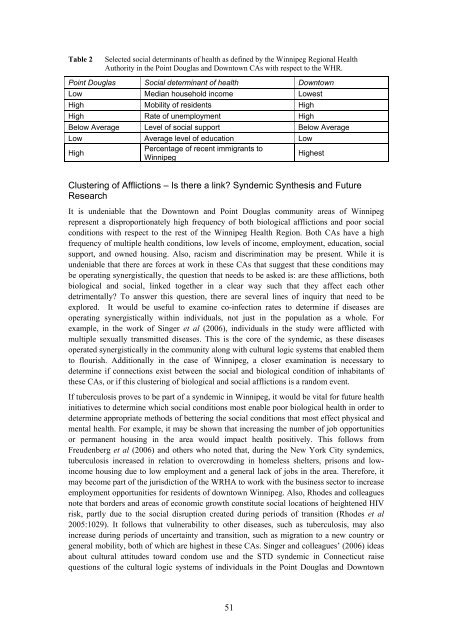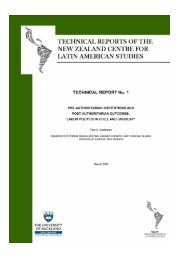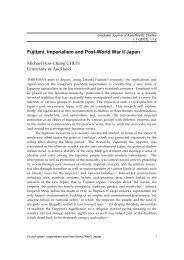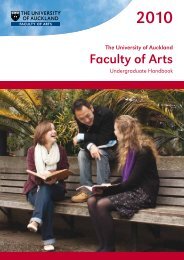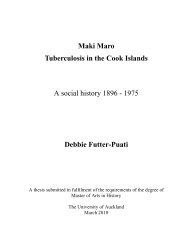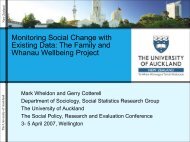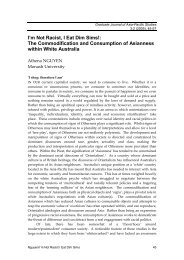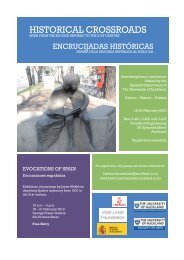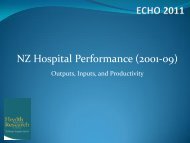Multiplying and Dividing - The University of Auckland
Multiplying and Dividing - The University of Auckland
Multiplying and Dividing - The University of Auckland
Create successful ePaper yourself
Turn your PDF publications into a flip-book with our unique Google optimized e-Paper software.
Table 2Selected social determinants <strong>of</strong> health as defined by the Winnipeg Regional HealthAuthority in the Point Douglas <strong>and</strong> Downtown CAs with respect to the WHR.Point Douglas Social determinant <strong>of</strong> health DowntownLow Median household income LowestHigh Mobility <strong>of</strong> residents HighHigh Rate <strong>of</strong> unemployment HighBelow Average Level <strong>of</strong> social support Below AverageLow Average level <strong>of</strong> education LowHighPercentage <strong>of</strong> recent immigrants toWinnipegHighestClustering <strong>of</strong> Afflictions – Is there a link? Syndemic Synthesis <strong>and</strong> FutureResearchIt is undeniable that the Downtown <strong>and</strong> Point Douglas community areas <strong>of</strong> Winnipegrepresent a disproportionately high frequency <strong>of</strong> both biological afflictions <strong>and</strong> poor socialconditions with respect to the rest <strong>of</strong> the Winnipeg Health Region. Both CAs have a highfrequency <strong>of</strong> multiple health conditions, low levels <strong>of</strong> income, employment, education, socialsupport, <strong>and</strong> owned housing. Also, racism <strong>and</strong> discrimination may be present. While it isundeniable that there are forces at work in these CAs that suggest that these conditions maybe operating synergistically, the question that needs to be asked is: are these afflictions, bothbiological <strong>and</strong> social, linked together in a clear way such that they affect each otherdetrimentally? To answer this question, there are several lines <strong>of</strong> inquiry that need to beexplored. It would be useful to examine co-infection rates to determine if diseases areoperating synergistically within individuals, not just in the population as a whole. Forexample, in the work <strong>of</strong> Singer et al (2006), individuals in the study were afflicted withmultiple sexually transmitted diseases. This is the core <strong>of</strong> the syndemic, as these diseasesoperated synergistically in the community along with cultural logic systems that enabled themto flourish. Additionally in the case <strong>of</strong> Winnipeg, a closer examination is necessary todetermine if connections exist between the social <strong>and</strong> biological condition <strong>of</strong> inhabitants <strong>of</strong>these CAs, or if this clustering <strong>of</strong> biological <strong>and</strong> social afflictions is a r<strong>and</strong>om event.If tuberculosis proves to be part <strong>of</strong> a syndemic in Winnipeg, it would be vital for future healthinitiatives to determine which social conditions most enable poor biological health in order todetermine appropriate methods <strong>of</strong> bettering the social conditions that most effect physical <strong>and</strong>mental health. For example, it may be shown that increasing the number <strong>of</strong> job opportunitiesor permanent housing in the area would impact health positively. This follows fromFreudenberg et al (2006) <strong>and</strong> others who noted that, during the New York City syndemics,tuberculosis increased in relation to overcrowding in homeless shelters, prisons <strong>and</strong> lowincomehousing due to low employment <strong>and</strong> a general lack <strong>of</strong> jobs in the area. <strong>The</strong>refore, itmay become part <strong>of</strong> the jurisdiction <strong>of</strong> the WRHA to work with the business sector to increaseemployment opportunities for residents <strong>of</strong> downtown Winnipeg. Also, Rhodes <strong>and</strong> colleaguesnote that borders <strong>and</strong> areas <strong>of</strong> economic growth constitute social locations <strong>of</strong> heightened HIVrisk, partly due to the social disruption created during periods <strong>of</strong> transition (Rhodes et al2005:1029). It follows that vulnerability to other diseases, such as tuberculosis, may alsoincrease during periods <strong>of</strong> uncertainty <strong>and</strong> transition, such as migration to a new country orgeneral mobility, both <strong>of</strong> which are highest in these CAs. Singer <strong>and</strong> colleagues’ (2006) ideasabout cultural attitudes toward condom use <strong>and</strong> the STD syndemic in Connecticut raisequestions <strong>of</strong> the cultural logic systems <strong>of</strong> individuals in the Point Douglas <strong>and</strong> Downtown51


